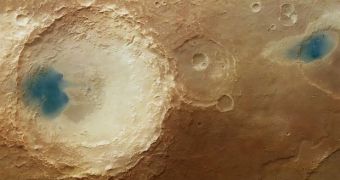A view of Mars made public earlier this week by researchers with the European Space Agency shows a couple of fairly bizarre blue splotches on the surface of this cosmic neighbor of ours.
Anybody even remotely familiar with astronomy knows that Mars also goes by the name of the Red Planet. Well then, how did these blue patches end up adorning its landscapes? And, most importantly, what are they?
Sorry, they're not Martian lagoons
Not to ruin anyone's dreams of one day going swimming on the Red Planet, but in a description accompanying this view of blue-hued patches on the surface of Mars, scientists say that the odd patches of color are no more and no less than an optical illusion.
As it turns out, these apparent blue lagoons on Mars are actually deposits of dark sediments that were carried to the area by winds. When imaged by the European Space Agency's Mars Express orbiter, the deposits appeared blue in color.
“It is an optical illusion caused by the image processing. The blue-hued patches lying within the ragged craters are actually dark sediments that have built up over time. This is due to the winds, which carry dark, volcanic, basalt-rich deposits across the planet,” researchers say.
Winds are forever shaping Mars
Winds on the Red Planet sometimes reach a speed of up to 100 kilometers per hour (about 62 miles per hour), European Space Agency astronomers explain.
Just like winds here on Earth, they birth colossal storms and shape landscapes by carrying dust and sand from one corner of the planet to another. Besides, they erode whatever geological feature they come across.
In fact, the impact craters featured in this latest Mars Express view of the Red Planet together with the blue splotches don't all look the same. Au contraire, some are fairly smooth, while others sport more rugged edges.
As explained by scientists, this is because, whereas some of these craters formed eons ago and have since been eroded by Martian winds, others are rather young and so still have clear features.

 14 DAY TRIAL //
14 DAY TRIAL //